TAXATION LAW Assignment - Taxation Law - Semester 2, 2024
VerifiedAdded on 2020/02/24
|14
|3106
|30
Homework Assignment
AI Summary
This document provides a comprehensive solution to a Taxation Law assignment, addressing various aspects of Australian taxation. It begins with an overview of the constitutional basis for taxation in Australia, including relevant sections of the Constitution and key legislation such as the Income Tax Assessment Act. The solution explores the sources of Australian tax law, including legislation, case law, and taxation rulings. It covers topics such as residential status, Medicare Levy, and the application of the Competition and Consumer Act. The assignment delves into specific provisions of the Income Tax Assessment Act, including deductions for losses arising from theft and the deductibility of repair expenses. The solution also examines methods for valuing stock items and provides calculations for tax liabilities based on income levels. Furthermore, the assignment analyzes the deductibility of various expenses, including tax agent fees and solicitor fees, and defines the concept of residency for tax purposes. It also explores the treatment of different types of income, including ordinary income, statutory income, and gifts. The solution also includes a section on the PAYG (Pay As You Go) income tax instalment system.

Running head: TAXATION LAW
Taxation Law
Name of the Student
Name of the University
Authors Note
Course ID
Taxation Law
Name of the Student
Name of the University
Authors Note
Course ID
Paraphrase This Document
Need a fresh take? Get an instant paraphrase of this document with our AI Paraphraser

1TAXATION LAW
Table of Contents
Answer to Part A:.......................................................................................................................2
Answer to question 1:.................................................................................................................2
Answer to question 2:.................................................................................................................2
Answer to Question 3:................................................................................................................2
Answer to question 4:.................................................................................................................3
Answer to Question 5.................................................................................................................3
Answer to Question 6.................................................................................................................3
Answer to Question 7.................................................................................................................4
Answer to Question 8.................................................................................................................4
Answer to Question 9.................................................................................................................5
Answer to question 10:...............................................................................................................5
Part B:.........................................................................................................................................5
Answer to Part C:.......................................................................................................................7
Answer to Part D:.......................................................................................................................8
Answer to Part E:.......................................................................................................................9
Reference List:.........................................................................................................................11
Table of Contents
Answer to Part A:.......................................................................................................................2
Answer to question 1:.................................................................................................................2
Answer to question 2:.................................................................................................................2
Answer to Question 3:................................................................................................................2
Answer to question 4:.................................................................................................................3
Answer to Question 5.................................................................................................................3
Answer to Question 6.................................................................................................................3
Answer to Question 7.................................................................................................................4
Answer to Question 8.................................................................................................................4
Answer to Question 9.................................................................................................................5
Answer to question 10:...............................................................................................................5
Part B:.........................................................................................................................................5
Answer to Part C:.......................................................................................................................7
Answer to Part D:.......................................................................................................................8
Answer to Part E:.......................................................................................................................9
Reference List:.........................................................................................................................11

2TAXATION LAW
Answer to Part A:
Answer to question 1:
In compliance with the Constitution of Australia, the main source of Commonwealth
Parliament’s power of taxation generally comes from the sections 51(ii), 53, 55, 90 and 96.
As defined under Section 51(ii) of Australian Constitution, the power of creating laws in
relation to tax is assigned with the Commonwealth Parliament (Pinto, 2011). It can be stated
that there are some conditions that those laws does not create any form of differentiation
between the states or parts of the states.
Answer to question 2:
Acts are mainly designed to establish the laws relating to tax. Hence, this forms the
primary source of Australian Taxation Laws that originates from the legislation with
numerous Parliamentary Acts and Regulations that are delegated in the legislation
(Braithwaite, 2017). The second source of Tax in Australia are the case laws that helps in
interpreting the legislation such as the judgment of court, tribunals etc. The third source of
taxation in Australia is the taxation rulings stated by the Commissioner of Taxation.
Answer to Question 3:
As per the Taxation Ruling TR 98/17 it is concerned with the residential status of an
individual entering in Australia (Cao et al., 2015). The Taxation Ruling TR 98/17 of is
applicable to most of the individuals that are entering Australia and comprises of the
following;
a. Any Migrants
Answer to Part A:
Answer to question 1:
In compliance with the Constitution of Australia, the main source of Commonwealth
Parliament’s power of taxation generally comes from the sections 51(ii), 53, 55, 90 and 96.
As defined under Section 51(ii) of Australian Constitution, the power of creating laws in
relation to tax is assigned with the Commonwealth Parliament (Pinto, 2011). It can be stated
that there are some conditions that those laws does not create any form of differentiation
between the states or parts of the states.
Answer to question 2:
Acts are mainly designed to establish the laws relating to tax. Hence, this forms the
primary source of Australian Taxation Laws that originates from the legislation with
numerous Parliamentary Acts and Regulations that are delegated in the legislation
(Braithwaite, 2017). The second source of Tax in Australia are the case laws that helps in
interpreting the legislation such as the judgment of court, tribunals etc. The third source of
taxation in Australia is the taxation rulings stated by the Commissioner of Taxation.
Answer to Question 3:
As per the Taxation Ruling TR 98/17 it is concerned with the residential status of an
individual entering in Australia (Cao et al., 2015). The Taxation Ruling TR 98/17 of is
applicable to most of the individuals that are entering Australia and comprises of the
following;
a. Any Migrants
⊘ This is a preview!⊘
Do you want full access?
Subscribe today to unlock all pages.

Trusted by 1+ million students worldwide
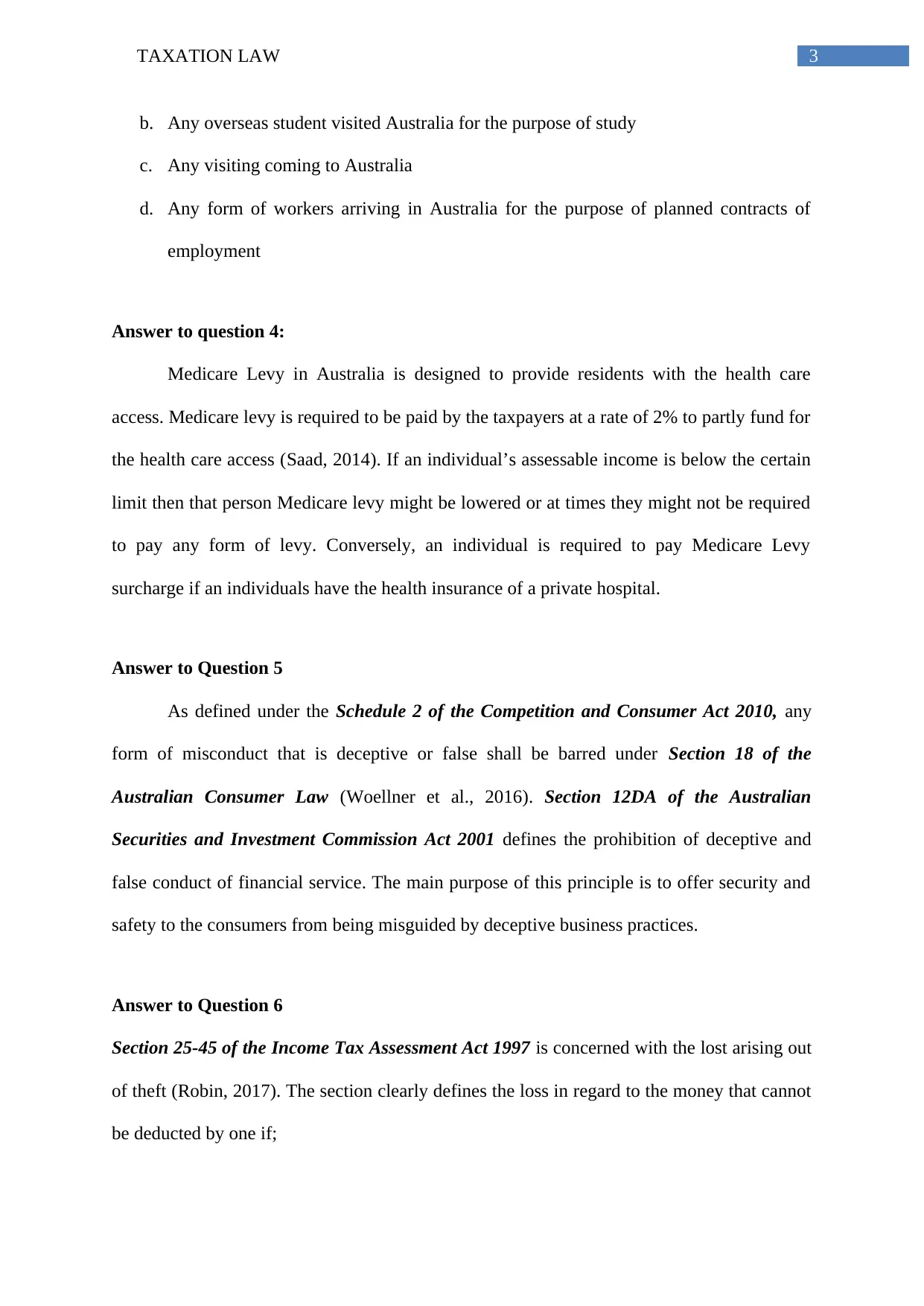
3TAXATION LAW
b. Any overseas student visited Australia for the purpose of study
c. Any visiting coming to Australia
d. Any form of workers arriving in Australia for the purpose of planned contracts of
employment
Answer to question 4:
Medicare Levy in Australia is designed to provide residents with the health care
access. Medicare levy is required to be paid by the taxpayers at a rate of 2% to partly fund for
the health care access (Saad, 2014). If an individual’s assessable income is below the certain
limit then that person Medicare levy might be lowered or at times they might not be required
to pay any form of levy. Conversely, an individual is required to pay Medicare Levy
surcharge if an individuals have the health insurance of a private hospital.
Answer to Question 5
As defined under the Schedule 2 of the Competition and Consumer Act 2010, any
form of misconduct that is deceptive or false shall be barred under Section 18 of the
Australian Consumer Law (Woellner et al., 2016). Section 12DA of the Australian
Securities and Investment Commission Act 2001 defines the prohibition of deceptive and
false conduct of financial service. The main purpose of this principle is to offer security and
safety to the consumers from being misguided by deceptive business practices.
Answer to Question 6
Section 25-45 of the Income Tax Assessment Act 1997 is concerned with the lost arising out
of theft (Robin, 2017). The section clearly defines the loss in regard to the money that cannot
be deducted by one if;
b. Any overseas student visited Australia for the purpose of study
c. Any visiting coming to Australia
d. Any form of workers arriving in Australia for the purpose of planned contracts of
employment
Answer to question 4:
Medicare Levy in Australia is designed to provide residents with the health care
access. Medicare levy is required to be paid by the taxpayers at a rate of 2% to partly fund for
the health care access (Saad, 2014). If an individual’s assessable income is below the certain
limit then that person Medicare levy might be lowered or at times they might not be required
to pay any form of levy. Conversely, an individual is required to pay Medicare Levy
surcharge if an individuals have the health insurance of a private hospital.
Answer to Question 5
As defined under the Schedule 2 of the Competition and Consumer Act 2010, any
form of misconduct that is deceptive or false shall be barred under Section 18 of the
Australian Consumer Law (Woellner et al., 2016). Section 12DA of the Australian
Securities and Investment Commission Act 2001 defines the prohibition of deceptive and
false conduct of financial service. The main purpose of this principle is to offer security and
safety to the consumers from being misguided by deceptive business practices.
Answer to Question 6
Section 25-45 of the Income Tax Assessment Act 1997 is concerned with the lost arising out
of theft (Robin, 2017). The section clearly defines the loss in regard to the money that cannot
be deducted by one if;
Paraphrase This Document
Need a fresh take? Get an instant paraphrase of this document with our AI Paraphraser
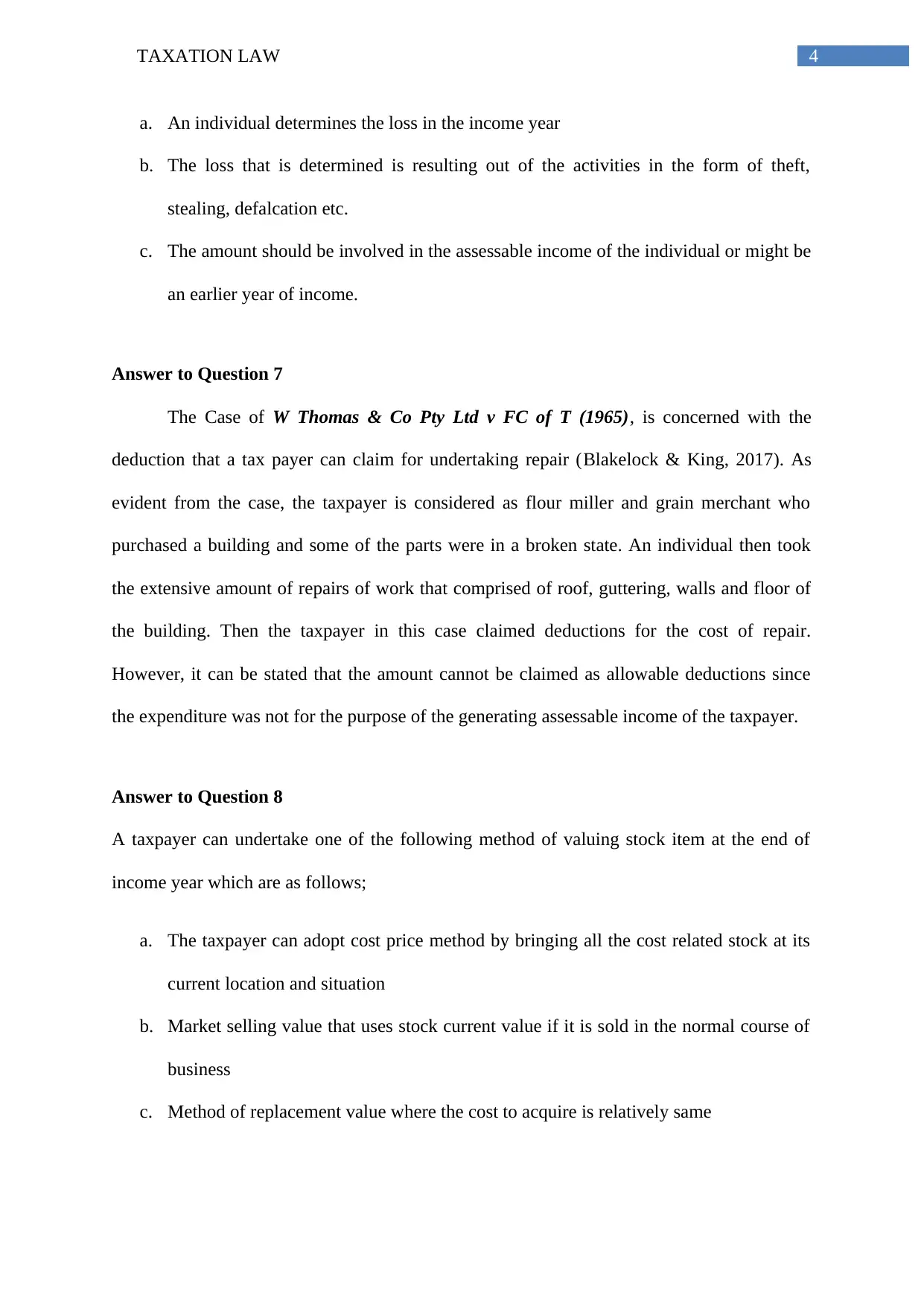
4TAXATION LAW
a. An individual determines the loss in the income year
b. The loss that is determined is resulting out of the activities in the form of theft,
stealing, defalcation etc.
c. The amount should be involved in the assessable income of the individual or might be
an earlier year of income.
Answer to Question 7
The Case of W Thomas & Co Pty Ltd v FC of T (1965), is concerned with the
deduction that a tax payer can claim for undertaking repair (Blakelock & King, 2017). As
evident from the case, the taxpayer is considered as flour miller and grain merchant who
purchased a building and some of the parts were in a broken state. An individual then took
the extensive amount of repairs of work that comprised of roof, guttering, walls and floor of
the building. Then the taxpayer in this case claimed deductions for the cost of repair.
However, it can be stated that the amount cannot be claimed as allowable deductions since
the expenditure was not for the purpose of the generating assessable income of the taxpayer.
Answer to Question 8
A taxpayer can undertake one of the following method of valuing stock item at the end of
income year which are as follows;
a. The taxpayer can adopt cost price method by bringing all the cost related stock at its
current location and situation
b. Market selling value that uses stock current value if it is sold in the normal course of
business
c. Method of replacement value where the cost to acquire is relatively same
a. An individual determines the loss in the income year
b. The loss that is determined is resulting out of the activities in the form of theft,
stealing, defalcation etc.
c. The amount should be involved in the assessable income of the individual or might be
an earlier year of income.
Answer to Question 7
The Case of W Thomas & Co Pty Ltd v FC of T (1965), is concerned with the
deduction that a tax payer can claim for undertaking repair (Blakelock & King, 2017). As
evident from the case, the taxpayer is considered as flour miller and grain merchant who
purchased a building and some of the parts were in a broken state. An individual then took
the extensive amount of repairs of work that comprised of roof, guttering, walls and floor of
the building. Then the taxpayer in this case claimed deductions for the cost of repair.
However, it can be stated that the amount cannot be claimed as allowable deductions since
the expenditure was not for the purpose of the generating assessable income of the taxpayer.
Answer to Question 8
A taxpayer can undertake one of the following method of valuing stock item at the end of
income year which are as follows;
a. The taxpayer can adopt cost price method by bringing all the cost related stock at its
current location and situation
b. Market selling value that uses stock current value if it is sold in the normal course of
business
c. Method of replacement value where the cost to acquire is relatively same
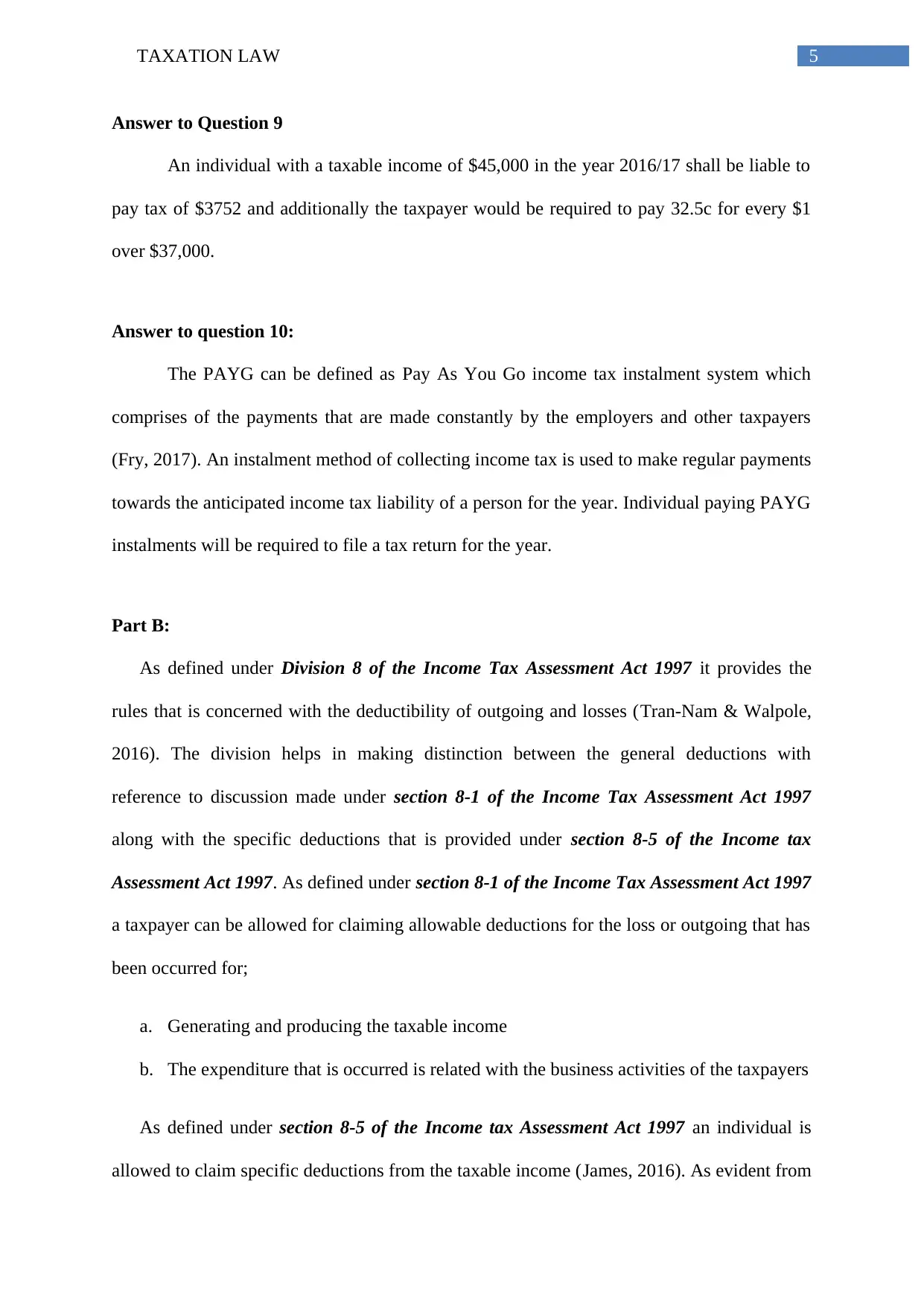
5TAXATION LAW
Answer to Question 9
An individual with a taxable income of $45,000 in the year 2016/17 shall be liable to
pay tax of $3752 and additionally the taxpayer would be required to pay 32.5c for every $1
over $37,000.
Answer to question 10:
The PAYG can be defined as Pay As You Go income tax instalment system which
comprises of the payments that are made constantly by the employers and other taxpayers
(Fry, 2017). An instalment method of collecting income tax is used to make regular payments
towards the anticipated income tax liability of a person for the year. Individual paying PAYG
instalments will be required to file a tax return for the year.
Part B:
As defined under Division 8 of the Income Tax Assessment Act 1997 it provides the
rules that is concerned with the deductibility of outgoing and losses (Tran-Nam & Walpole,
2016). The division helps in making distinction between the general deductions with
reference to discussion made under section 8-1 of the Income Tax Assessment Act 1997
along with the specific deductions that is provided under section 8-5 of the Income tax
Assessment Act 1997. As defined under section 8-1 of the Income Tax Assessment Act 1997
a taxpayer can be allowed for claiming allowable deductions for the loss or outgoing that has
been occurred for;
a. Generating and producing the taxable income
b. The expenditure that is occurred is related with the business activities of the taxpayers
As defined under section 8-5 of the Income tax Assessment Act 1997 an individual is
allowed to claim specific deductions from the taxable income (James, 2016). As evident from
Answer to Question 9
An individual with a taxable income of $45,000 in the year 2016/17 shall be liable to
pay tax of $3752 and additionally the taxpayer would be required to pay 32.5c for every $1
over $37,000.
Answer to question 10:
The PAYG can be defined as Pay As You Go income tax instalment system which
comprises of the payments that are made constantly by the employers and other taxpayers
(Fry, 2017). An instalment method of collecting income tax is used to make regular payments
towards the anticipated income tax liability of a person for the year. Individual paying PAYG
instalments will be required to file a tax return for the year.
Part B:
As defined under Division 8 of the Income Tax Assessment Act 1997 it provides the
rules that is concerned with the deductibility of outgoing and losses (Tran-Nam & Walpole,
2016). The division helps in making distinction between the general deductions with
reference to discussion made under section 8-1 of the Income Tax Assessment Act 1997
along with the specific deductions that is provided under section 8-5 of the Income tax
Assessment Act 1997. As defined under section 8-1 of the Income Tax Assessment Act 1997
a taxpayer can be allowed for claiming allowable deductions for the loss or outgoing that has
been occurred for;
a. Generating and producing the taxable income
b. The expenditure that is occurred is related with the business activities of the taxpayers
As defined under section 8-5 of the Income tax Assessment Act 1997 an individual is
allowed to claim specific deductions from the taxable income (James, 2016). As evident from
⊘ This is a preview!⊘
Do you want full access?
Subscribe today to unlock all pages.

Trusted by 1+ million students worldwide
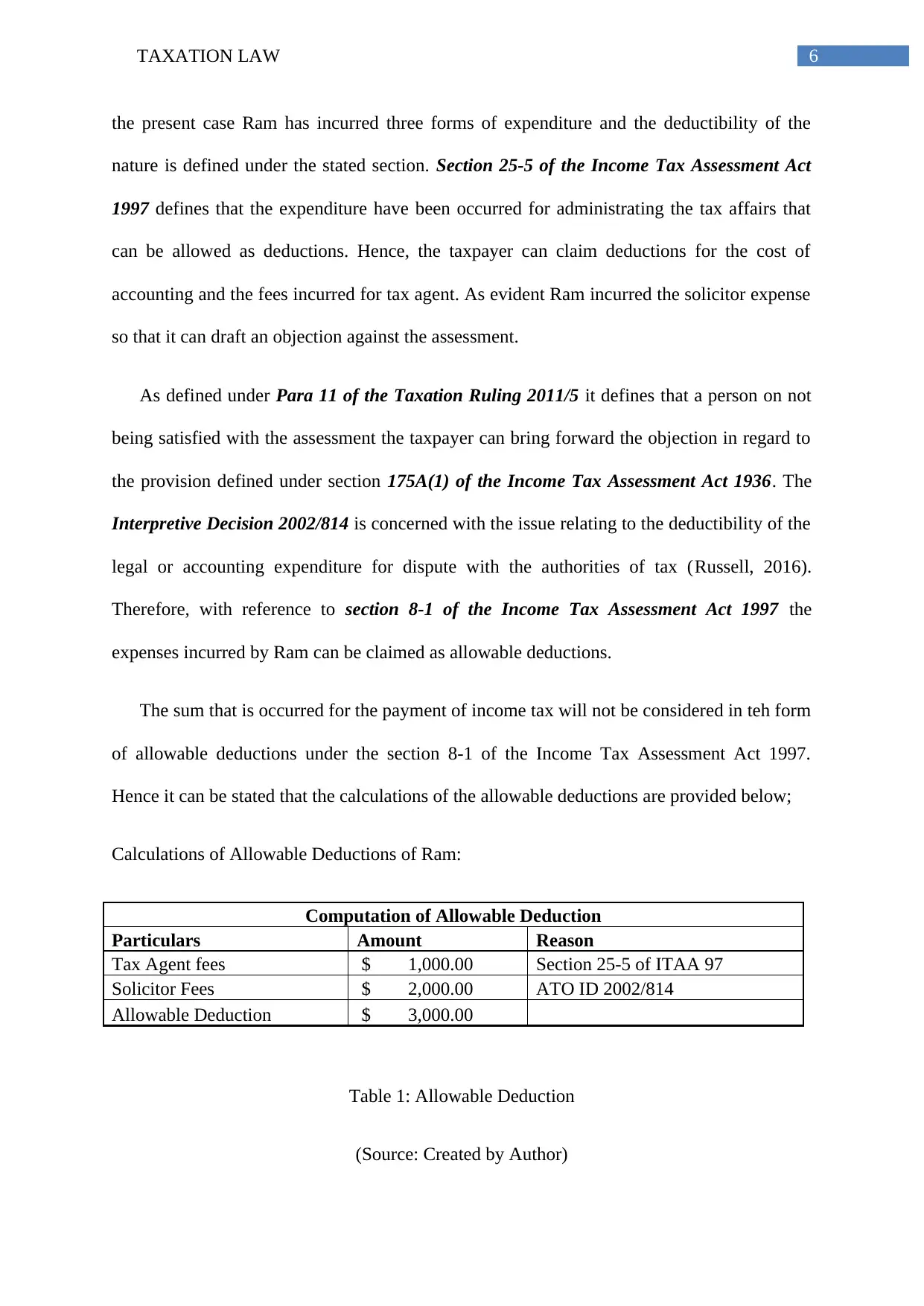
6TAXATION LAW
the present case Ram has incurred three forms of expenditure and the deductibility of the
nature is defined under the stated section. Section 25-5 of the Income Tax Assessment Act
1997 defines that the expenditure have been occurred for administrating the tax affairs that
can be allowed as deductions. Hence, the taxpayer can claim deductions for the cost of
accounting and the fees incurred for tax agent. As evident Ram incurred the solicitor expense
so that it can draft an objection against the assessment.
As defined under Para 11 of the Taxation Ruling 2011/5 it defines that a person on not
being satisfied with the assessment the taxpayer can bring forward the objection in regard to
the provision defined under section 175A(1) of the Income Tax Assessment Act 1936. The
Interpretive Decision 2002/814 is concerned with the issue relating to the deductibility of the
legal or accounting expenditure for dispute with the authorities of tax (Russell, 2016).
Therefore, with reference to section 8-1 of the Income Tax Assessment Act 1997 the
expenses incurred by Ram can be claimed as allowable deductions.
The sum that is occurred for the payment of income tax will not be considered in teh form
of allowable deductions under the section 8-1 of the Income Tax Assessment Act 1997.
Hence it can be stated that the calculations of the allowable deductions are provided below;
Calculations of Allowable Deductions of Ram:
Computation of Allowable Deduction
Particulars Amount Reason
Tax Agent fees $ 1,000.00 Section 25-5 of ITAA 97
Solicitor Fees $ 2,000.00 ATO ID 2002/814
Allowable Deduction $ 3,000.00
Table 1: Allowable Deduction
(Source: Created by Author)
the present case Ram has incurred three forms of expenditure and the deductibility of the
nature is defined under the stated section. Section 25-5 of the Income Tax Assessment Act
1997 defines that the expenditure have been occurred for administrating the tax affairs that
can be allowed as deductions. Hence, the taxpayer can claim deductions for the cost of
accounting and the fees incurred for tax agent. As evident Ram incurred the solicitor expense
so that it can draft an objection against the assessment.
As defined under Para 11 of the Taxation Ruling 2011/5 it defines that a person on not
being satisfied with the assessment the taxpayer can bring forward the objection in regard to
the provision defined under section 175A(1) of the Income Tax Assessment Act 1936. The
Interpretive Decision 2002/814 is concerned with the issue relating to the deductibility of the
legal or accounting expenditure for dispute with the authorities of tax (Russell, 2016).
Therefore, with reference to section 8-1 of the Income Tax Assessment Act 1997 the
expenses incurred by Ram can be claimed as allowable deductions.
The sum that is occurred for the payment of income tax will not be considered in teh form
of allowable deductions under the section 8-1 of the Income Tax Assessment Act 1997.
Hence it can be stated that the calculations of the allowable deductions are provided below;
Calculations of Allowable Deductions of Ram:
Computation of Allowable Deduction
Particulars Amount Reason
Tax Agent fees $ 1,000.00 Section 25-5 of ITAA 97
Solicitor Fees $ 2,000.00 ATO ID 2002/814
Allowable Deduction $ 3,000.00
Table 1: Allowable Deduction
(Source: Created by Author)
Paraphrase This Document
Need a fresh take? Get an instant paraphrase of this document with our AI Paraphraser

7TAXATION LAW
Answer to Part C:
The term “Resident” is stated under section 995-1 of the Income Tax Assessment Act
1997 which explains that an individual will be considered as Australian resident for the
purpose of taxation (Dunne et al., 2016). Section 6-1 of the Income Tax Assessment Act
1936 lays down definition of resident and reflects the primary test for deciding the residential
status of the individual. As defined under the Para 32 of the Taxation Ruling 98/17 it is
defined that a person can be considered as resident in compliance with the section 6-1 of the
Income tax Assessment Act 1936.
Section 6-1 of the Income tax Assessment Act 1936 defines four test of residency stated
below
a. Residential status in terms of the ordinary concept
b. Domicile test or the permanent place of abode
c. 183 days test; and
d. Superannuation fund test;
The taxpayer was born and residing in Australia will be considered as an Australian
resident for taxation purpose with ordinary concept. If an individual is not considered as
resident in terms of the ordinary concept then the statutory test is implemented in determining
the residential status and on satisfying the primary test the person shall be considered as
resident. As per the domicile test an individual with permanent place of abode in Australia
will be considered as the resident of Australia for the taxation purpose. The rule of 183 days
defines an individual to be an Australian resident if the person has been present in Australia
for a period of not less than six months either constantly or in breaks. The superannuation test
is applied for the Australian government employees working on overseas employment. The
law further defines that an individual shall be regarded as Australian resident if an individual
Answer to Part C:
The term “Resident” is stated under section 995-1 of the Income Tax Assessment Act
1997 which explains that an individual will be considered as Australian resident for the
purpose of taxation (Dunne et al., 2016). Section 6-1 of the Income Tax Assessment Act
1936 lays down definition of resident and reflects the primary test for deciding the residential
status of the individual. As defined under the Para 32 of the Taxation Ruling 98/17 it is
defined that a person can be considered as resident in compliance with the section 6-1 of the
Income tax Assessment Act 1936.
Section 6-1 of the Income tax Assessment Act 1936 defines four test of residency stated
below
a. Residential status in terms of the ordinary concept
b. Domicile test or the permanent place of abode
c. 183 days test; and
d. Superannuation fund test;
The taxpayer was born and residing in Australia will be considered as an Australian
resident for taxation purpose with ordinary concept. If an individual is not considered as
resident in terms of the ordinary concept then the statutory test is implemented in determining
the residential status and on satisfying the primary test the person shall be considered as
resident. As per the domicile test an individual with permanent place of abode in Australia
will be considered as the resident of Australia for the taxation purpose. The rule of 183 days
defines an individual to be an Australian resident if the person has been present in Australia
for a period of not less than six months either constantly or in breaks. The superannuation test
is applied for the Australian government employees working on overseas employment. The
law further defines that an individual shall be regarded as Australian resident if an individual

8TAXATION LAW
enrols in a course having a duration of more than six. As evident in the present scenario of
Tina, she arrived in Australia for the purpose of study and her stay lasted for more than 183
days. As a result of this she will be considered as the Australian resident for the purpose of
taxation.
Answer to Part D:
An individual is taxed for their income across derived from all parts of the world. As
defined under section 4-15 of the Income Tax Assessment Act 1997 it lays down that the
taxable income is computed by deducting the allowable deductions from the taxable income
(Ato.gov.au, 2017). Section 6-5 of the Income tax Assessment Act 1997 categorizes
assessable income in the form of ordinary income and the statutory income is defined under
section 6-10 of the Income tax Assessment Act 1997. On the other hand, income that does
not form the part of the ordinary income is considered as statutory income under section 6-10
of the ITAA 97. This represents that the income that is earned by Jimmy by working in
restaurant in the form of taxpayer is considered as ordinary income under and it will be
considered taxable under section 6-5 of the ITAA 97.
The tips that are received by the customers in the form of incentive which is directly
related to the employment shall be considered in the form of taxable income. The receipt of
sum by the individual will not be considered for taxation purpose. As evident from the
present scenario of Jimmy it has been found that the receipt of $250 as a gift is considered as
taxable (Ato.gov.au, 2017). There are some forms of incomes that are included in the
assessable income since they are exempted from being considered as income under section 6-
20 of the Income Tax Assessment Act 1997.
Gifts are usually not considered for taxation however if it received as in the form of
part of business activity or received in the form of income generating activity then it is
enrols in a course having a duration of more than six. As evident in the present scenario of
Tina, she arrived in Australia for the purpose of study and her stay lasted for more than 183
days. As a result of this she will be considered as the Australian resident for the purpose of
taxation.
Answer to Part D:
An individual is taxed for their income across derived from all parts of the world. As
defined under section 4-15 of the Income Tax Assessment Act 1997 it lays down that the
taxable income is computed by deducting the allowable deductions from the taxable income
(Ato.gov.au, 2017). Section 6-5 of the Income tax Assessment Act 1997 categorizes
assessable income in the form of ordinary income and the statutory income is defined under
section 6-10 of the Income tax Assessment Act 1997. On the other hand, income that does
not form the part of the ordinary income is considered as statutory income under section 6-10
of the ITAA 97. This represents that the income that is earned by Jimmy by working in
restaurant in the form of taxpayer is considered as ordinary income under and it will be
considered taxable under section 6-5 of the ITAA 97.
The tips that are received by the customers in the form of incentive which is directly
related to the employment shall be considered in the form of taxable income. The receipt of
sum by the individual will not be considered for taxation purpose. As evident from the
present scenario of Jimmy it has been found that the receipt of $250 as a gift is considered as
taxable (Ato.gov.au, 2017). There are some forms of incomes that are included in the
assessable income since they are exempted from being considered as income under section 6-
20 of the Income Tax Assessment Act 1997.
Gifts are usually not considered for taxation however if it received as in the form of
part of business activity or received in the form of income generating activity then it is
⊘ This is a preview!⊘
Do you want full access?
Subscribe today to unlock all pages.

Trusted by 1+ million students worldwide
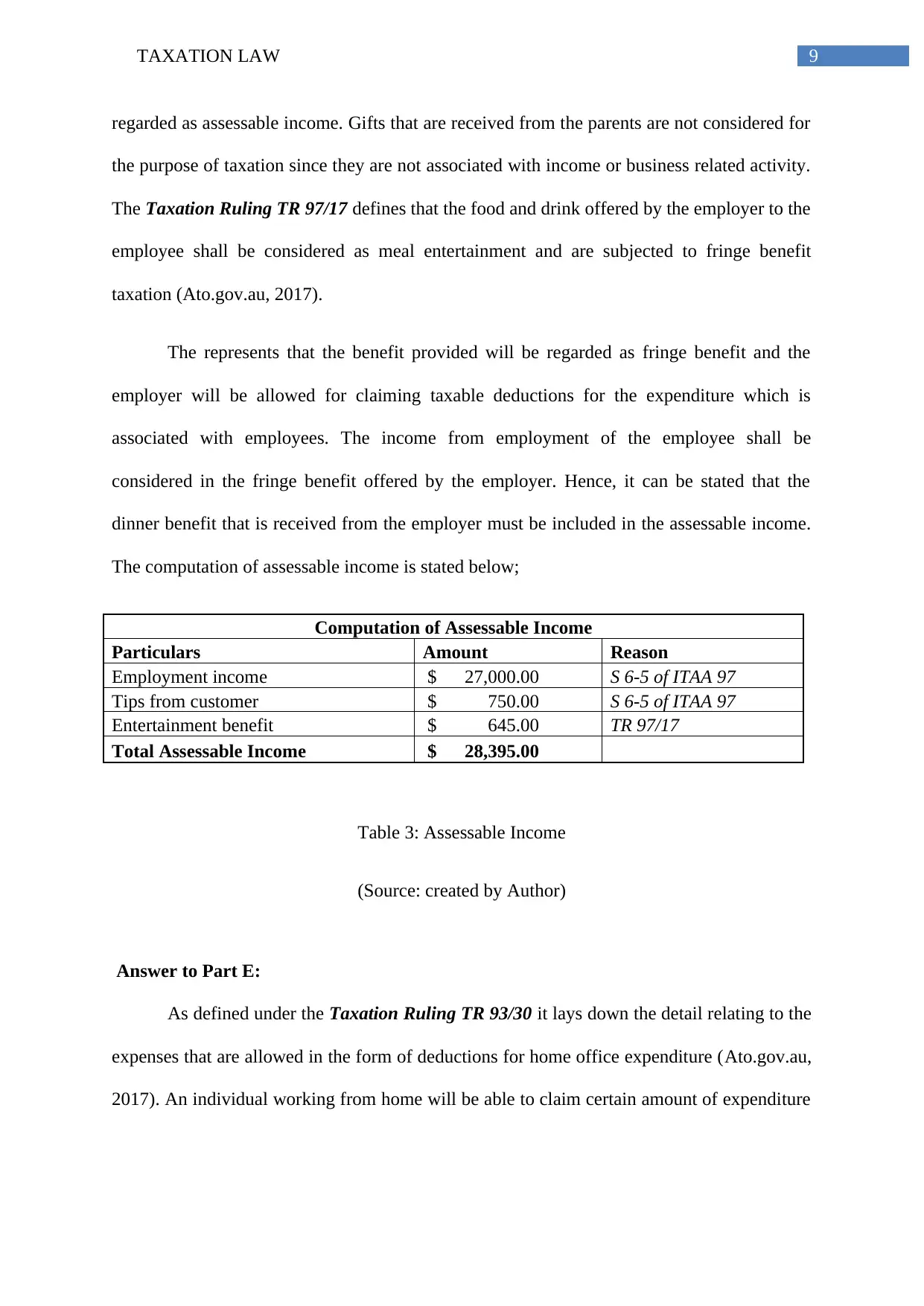
9TAXATION LAW
regarded as assessable income. Gifts that are received from the parents are not considered for
the purpose of taxation since they are not associated with income or business related activity.
The Taxation Ruling TR 97/17 defines that the food and drink offered by the employer to the
employee shall be considered as meal entertainment and are subjected to fringe benefit
taxation (Ato.gov.au, 2017).
The represents that the benefit provided will be regarded as fringe benefit and the
employer will be allowed for claiming taxable deductions for the expenditure which is
associated with employees. The income from employment of the employee shall be
considered in the fringe benefit offered by the employer. Hence, it can be stated that the
dinner benefit that is received from the employer must be included in the assessable income.
The computation of assessable income is stated below;
Computation of Assessable Income
Particulars Amount Reason
Employment income $ 27,000.00 S 6-5 of ITAA 97
Tips from customer $ 750.00 S 6-5 of ITAA 97
Entertainment benefit $ 645.00 TR 97/17
Total Assessable Income $ 28,395.00
Table 3: Assessable Income
(Source: created by Author)
Answer to Part E:
As defined under the Taxation Ruling TR 93/30 it lays down the detail relating to the
expenses that are allowed in the form of deductions for home office expenditure (Ato.gov.au,
2017). An individual working from home will be able to claim certain amount of expenditure
regarded as assessable income. Gifts that are received from the parents are not considered for
the purpose of taxation since they are not associated with income or business related activity.
The Taxation Ruling TR 97/17 defines that the food and drink offered by the employer to the
employee shall be considered as meal entertainment and are subjected to fringe benefit
taxation (Ato.gov.au, 2017).
The represents that the benefit provided will be regarded as fringe benefit and the
employer will be allowed for claiming taxable deductions for the expenditure which is
associated with employees. The income from employment of the employee shall be
considered in the fringe benefit offered by the employer. Hence, it can be stated that the
dinner benefit that is received from the employer must be included in the assessable income.
The computation of assessable income is stated below;
Computation of Assessable Income
Particulars Amount Reason
Employment income $ 27,000.00 S 6-5 of ITAA 97
Tips from customer $ 750.00 S 6-5 of ITAA 97
Entertainment benefit $ 645.00 TR 97/17
Total Assessable Income $ 28,395.00
Table 3: Assessable Income
(Source: created by Author)
Answer to Part E:
As defined under the Taxation Ruling TR 93/30 it lays down the detail relating to the
expenses that are allowed in the form of deductions for home office expenditure (Ato.gov.au,
2017). An individual working from home will be able to claim certain amount of expenditure
Paraphrase This Document
Need a fresh take? Get an instant paraphrase of this document with our AI Paraphraser
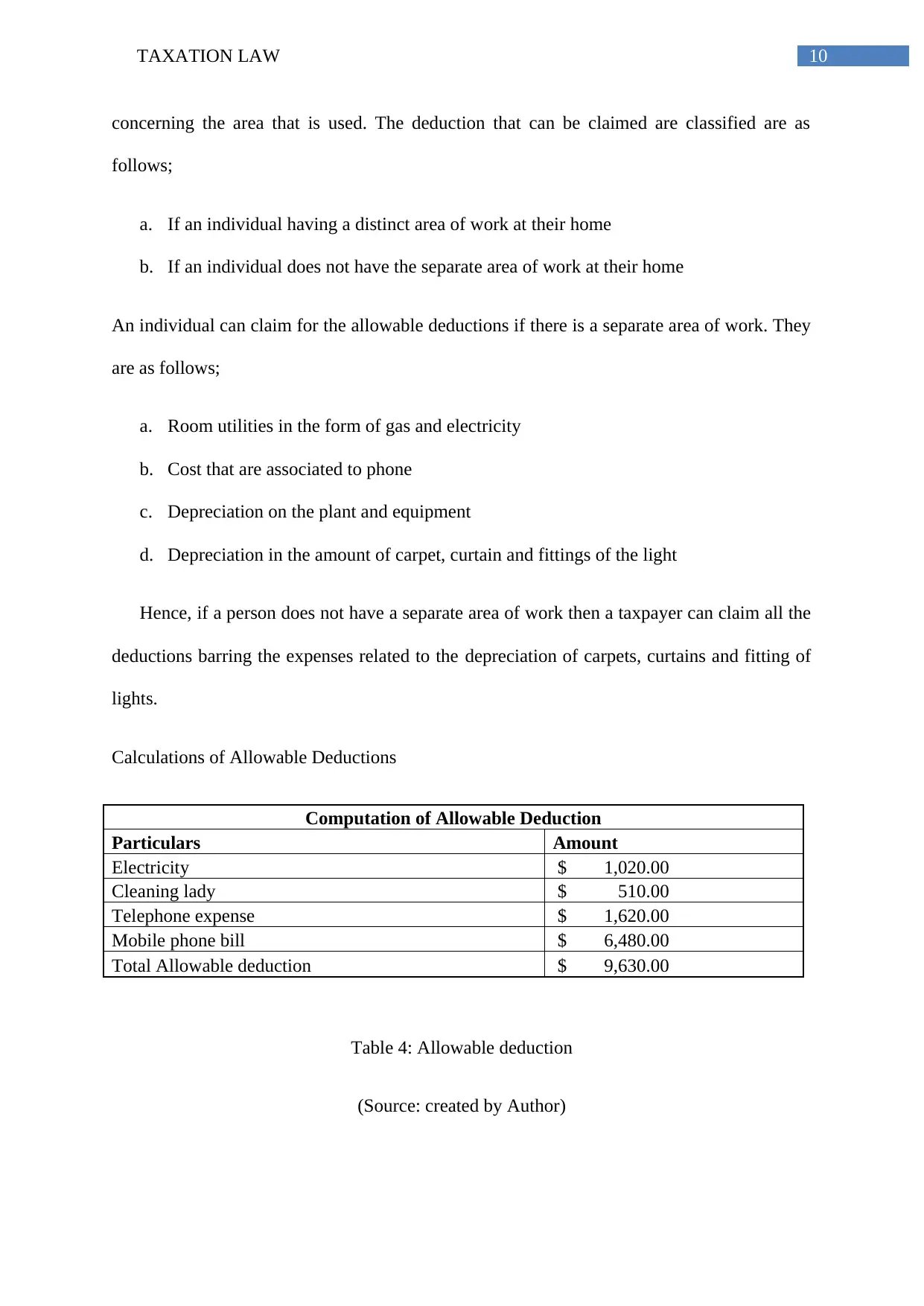
10TAXATION LAW
concerning the area that is used. The deduction that can be claimed are classified are as
follows;
a. If an individual having a distinct area of work at their home
b. If an individual does not have the separate area of work at their home
An individual can claim for the allowable deductions if there is a separate area of work. They
are as follows;
a. Room utilities in the form of gas and electricity
b. Cost that are associated to phone
c. Depreciation on the plant and equipment
d. Depreciation in the amount of carpet, curtain and fittings of the light
Hence, if a person does not have a separate area of work then a taxpayer can claim all the
deductions barring the expenses related to the depreciation of carpets, curtains and fitting of
lights.
Calculations of Allowable Deductions
Computation of Allowable Deduction
Particulars Amount
Electricity $ 1,020.00
Cleaning lady $ 510.00
Telephone expense $ 1,620.00
Mobile phone bill $ 6,480.00
Total Allowable deduction $ 9,630.00
Table 4: Allowable deduction
(Source: created by Author)
concerning the area that is used. The deduction that can be claimed are classified are as
follows;
a. If an individual having a distinct area of work at their home
b. If an individual does not have the separate area of work at their home
An individual can claim for the allowable deductions if there is a separate area of work. They
are as follows;
a. Room utilities in the form of gas and electricity
b. Cost that are associated to phone
c. Depreciation on the plant and equipment
d. Depreciation in the amount of carpet, curtain and fittings of the light
Hence, if a person does not have a separate area of work then a taxpayer can claim all the
deductions barring the expenses related to the depreciation of carpets, curtains and fitting of
lights.
Calculations of Allowable Deductions
Computation of Allowable Deduction
Particulars Amount
Electricity $ 1,020.00
Cleaning lady $ 510.00
Telephone expense $ 1,620.00
Mobile phone bill $ 6,480.00
Total Allowable deduction $ 9,630.00
Table 4: Allowable deduction
(Source: created by Author)
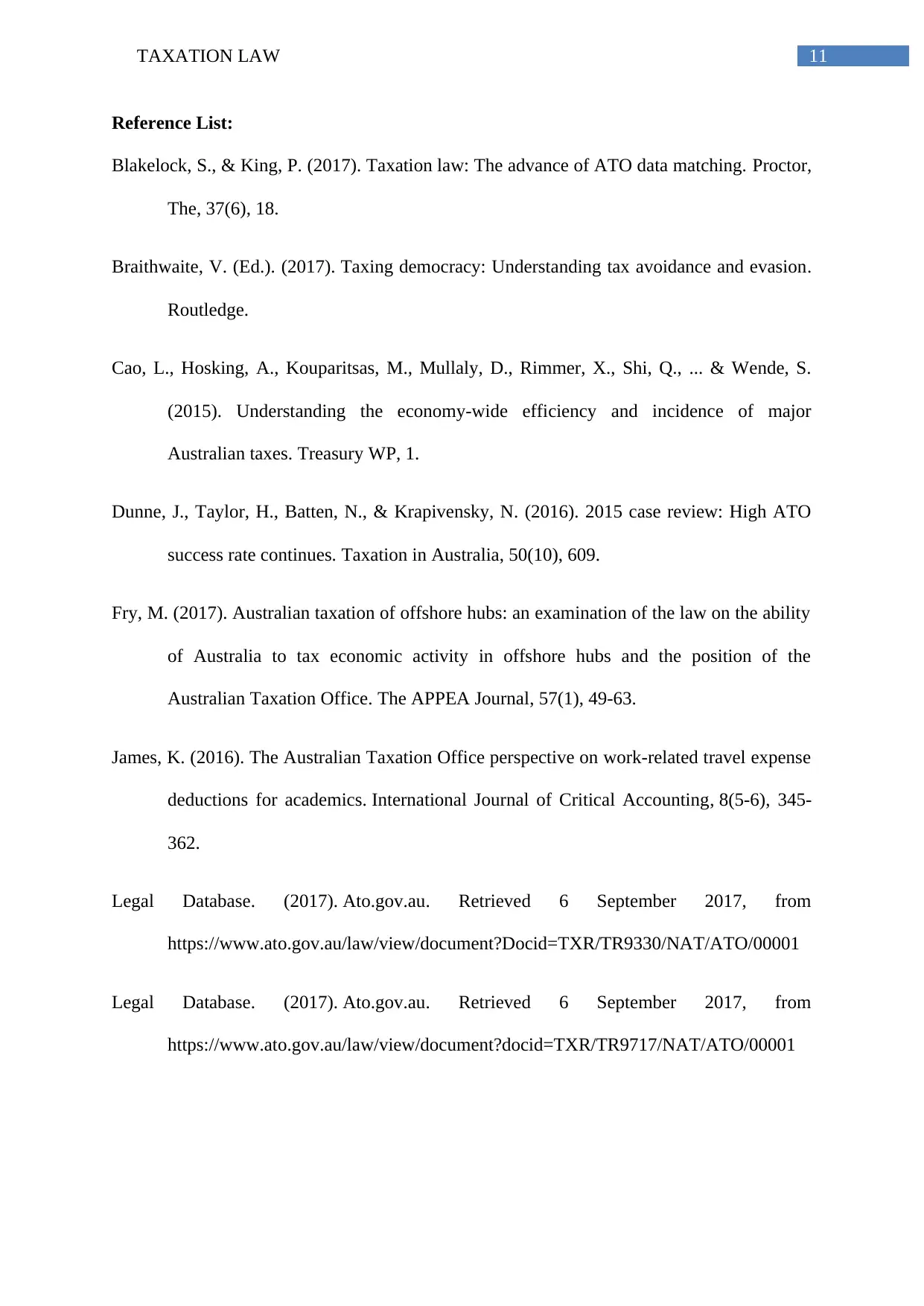
11TAXATION LAW
Reference List:
Blakelock, S., & King, P. (2017). Taxation law: The advance of ATO data matching. Proctor,
The, 37(6), 18.
Braithwaite, V. (Ed.). (2017). Taxing democracy: Understanding tax avoidance and evasion.
Routledge.
Cao, L., Hosking, A., Kouparitsas, M., Mullaly, D., Rimmer, X., Shi, Q., ... & Wende, S.
(2015). Understanding the economy-wide efficiency and incidence of major
Australian taxes. Treasury WP, 1.
Dunne, J., Taylor, H., Batten, N., & Krapivensky, N. (2016). 2015 case review: High ATO
success rate continues. Taxation in Australia, 50(10), 609.
Fry, M. (2017). Australian taxation of offshore hubs: an examination of the law on the ability
of Australia to tax economic activity in offshore hubs and the position of the
Australian Taxation Office. The APPEA Journal, 57(1), 49-63.
James, K. (2016). The Australian Taxation Office perspective on work-related travel expense
deductions for academics. International Journal of Critical Accounting, 8(5-6), 345-
362.
Legal Database. (2017). Ato.gov.au. Retrieved 6 September 2017, from
https://www.ato.gov.au/law/view/document?Docid=TXR/TR9330/NAT/ATO/00001
Legal Database. (2017). Ato.gov.au. Retrieved 6 September 2017, from
https://www.ato.gov.au/law/view/document?docid=TXR/TR9717/NAT/ATO/00001
Reference List:
Blakelock, S., & King, P. (2017). Taxation law: The advance of ATO data matching. Proctor,
The, 37(6), 18.
Braithwaite, V. (Ed.). (2017). Taxing democracy: Understanding tax avoidance and evasion.
Routledge.
Cao, L., Hosking, A., Kouparitsas, M., Mullaly, D., Rimmer, X., Shi, Q., ... & Wende, S.
(2015). Understanding the economy-wide efficiency and incidence of major
Australian taxes. Treasury WP, 1.
Dunne, J., Taylor, H., Batten, N., & Krapivensky, N. (2016). 2015 case review: High ATO
success rate continues. Taxation in Australia, 50(10), 609.
Fry, M. (2017). Australian taxation of offshore hubs: an examination of the law on the ability
of Australia to tax economic activity in offshore hubs and the position of the
Australian Taxation Office. The APPEA Journal, 57(1), 49-63.
James, K. (2016). The Australian Taxation Office perspective on work-related travel expense
deductions for academics. International Journal of Critical Accounting, 8(5-6), 345-
362.
Legal Database. (2017). Ato.gov.au. Retrieved 6 September 2017, from
https://www.ato.gov.au/law/view/document?Docid=TXR/TR9330/NAT/ATO/00001
Legal Database. (2017). Ato.gov.au. Retrieved 6 September 2017, from
https://www.ato.gov.au/law/view/document?docid=TXR/TR9717/NAT/ATO/00001
⊘ This is a preview!⊘
Do you want full access?
Subscribe today to unlock all pages.

Trusted by 1+ million students worldwide
1 out of 14
Related Documents
Your All-in-One AI-Powered Toolkit for Academic Success.
+13062052269
info@desklib.com
Available 24*7 on WhatsApp / Email
![[object Object]](/_next/static/media/star-bottom.7253800d.svg)
Unlock your academic potential
Copyright © 2020–2025 A2Z Services. All Rights Reserved. Developed and managed by ZUCOL.





